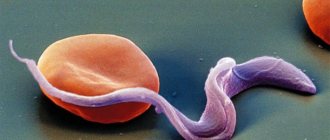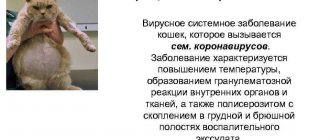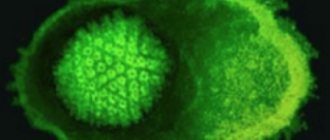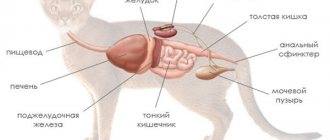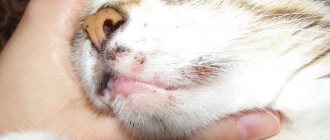Just like people, animals can suffer from acute infectious diseases. If you do not start timely treatment of herpes in cats, it can develop into rhinotracheitis - a dangerous pathology that kills 50 percent of sick four-legged pets. Therefore, a pet owner needs to be able to diagnose the virus in the early stages of development. This disease is not transmitted to humans.
Modes of infection and susceptibility
In most cases, animals become infected with herpes through contact with a carrier of the infection. This can happen in institutions, public transport, while walking, and so on. The virus can be transmitted in the following ways:
- contact - through bedding, furniture, tray, clothing;
- sexual - upon contact of mucous areas of animals;
- from cat to kittens - if an adult animal has herpes, babies can become infected through milk.
Feline and human herpes are caused by completely different types of viruses, so humans and cats cannot catch the disease from each other. The virus is especially dangerous for kittens. It is excreted from mother's milk, so babies can get sick in the first days of life. A weak body is unable to fight such a disease, so kittens rarely survive.
The infection spreads throughout the body very quickly. The situation is extremely bad if there are a large number of pets in one room, for example, in nurseries. Then the pathology turns into a real epidemic. When more than two cats in a group become ill, the likelihood of the virus spreading quickly increases many times over. In addition, there are so -called stress factors that increase the likelihood of infection . These include:
- hypothermia of the body;
- keeping the animal in unsanitary conditions;
- improper feeding;
- deficiency of vitamins and minerals in the diet;
- stress due to rough treatment or physical violence.
What is herpes virus infection
Feline herpesvirus has a complex name - Feline viral rinotracheitis-2.
Herpes virus infection in cats affects the mucous membranes of various organs of the animal, for example, tonsils and nasopharynx, and often spreads to the lymph nodes. Without proper treatment, herpes can develop into rhinotracheitis. Rhinotracheitis in cats is a dangerous viral pathology that affects the mucous membranes of the eyes and respiratory tract. The acute course of rhinotracheitis lasts from seven to ten days. Often accompanied by pneumonia.
Causes of herpes viral infection in cats
Most often, herpes virus infection develops in animals with weakened immune systems and, above all, in kittens. Unfortunately, very young kittens (less than 1 month old) rarely survive when they get herpes - their unprotected body is not yet able to resist such a disease.
Also, the cause of the disease can be insufficient nutrition, hypothermia - or almost anything.
Herpes therapy must be carried out under the supervision of a veterinarian. At the very beginning of the development of the inflammatory process, it is impossible to diagnose herpes - it is at the stage of the incubation period and proceeds latently. This period lasts 7–10 days.
In nurseries, herpes can become an epidemic, since during the incubation period this disease does not manifest itself in any way and there is a risk of infecting a large number of animals.
The best way to avoid an epidemic is to quarantine all newly arrived animals, but this, unfortunately, cannot completely eliminate the possibility of infection, because the virus may end up, for example, in water or soil. And then an epidemic begins in the nursery, which often ends in the death of some of the wards.
How does infection occur?
Feline herpes is transmitted by airborne droplets. Once in water or soil, the virus remains there for a long time. To become infected, a healthy animal will only need contact with an infected environment or a sick cat.
The virus is very susceptible to high temperatures and an alkaline environment, so it cannot survive in this state for a long time.
So we are not talking about infecting people with the feline herpes virus or rhinotracheitis. Other animals are also not susceptible to this virus.
Which individuals are most susceptible to the virus?
As mentioned above, carriers of the virus are often cats with poor immunity and kittens.
If a pregnant or lactating cat becomes infected with herpes, the likelihood of miscarriage or subsequent death of all offspring is very high.
Types of disease progression
Feline herpesvirus does not always follow a single pattern. In veterinary medicine, there are two main types of disease development:
- Spicy. The animal is sick for about two weeks. With proper treatment, the pet recovers, the likelihood of death is very low. Sad consequences are only possible if the cat’s immunity was severely weakened or if we are talking about a kitten under 1 month old.
- Chronic. If herpes is not diagnosed and treated in a timely manner, it can develop into rhinotracheitis. This dangerous disease lasts about six weeks and can lead to a number of consequences. Blindness, ulcerative keratitis or panophthalmia are possible.
Diagnosis
Diagnosis of the disease is made in veterinary institutions based on tests and the clinical picture of the disease. This is necessary in order not to confuse herpes infection with calcivirus, the clinical picture of which has similar symptoms.
To detect the presence of the herpes virus, it is necessary to send the discharge for analysis.
The virus veterinary laboratory will test samples for the presence of virus bodies.
If they are detected, the animal will be diagnosed with rhinotracheitis.
The disease can occur in two forms: acute and chronic.
- The acute form lasts about two weeks and, most often, ends with recovery.
- Chronic form - can last up to one and a half months. To all the symptoms inherent in herpes is added the development of ulcerative keratitis and blindness.
Reference!
Lethal outcome is possible only when the virus is introduced into the body of a kitten or animal with very weak immunity.
Signs of pathology
Herpes virus infection cannot be diagnosed the day after infection, since the incubation period begins first. The first symptoms appear in a cat after about a week. Typically, herpes appears on the nose or lip. The pet owner may notice small white bubbles. This is the main sign of the disease. In addition, there are other symptoms of herpes in cats in the initial stages:
- conjunctivitis;
- swelling;
- mucus secretion;
- the appearance of ulcers in the lips or nose.
If the cat's owner does not pay attention to the symptoms of the disease in the first days of its appearance, the pathology can develop into an acute stage within a few days. In an advanced form of the disease, the animal may die or the virus may enter a chronic stage.
Advanced pathology is characterized by the following symptoms:
- weak appetite;
- increased body temperature;
- lethargy;
- cardiopalmus;
- heavy salivation;
- heart failure;
- cough with sputum production;
- sinus congestion.
If the owner observes a deterioration in the pet's condition, they should contact a veterinarian as soon as possible. This will prevent complications and the occurrence of other dangerous diseases.
Rhinoracheitis in cats: symptoms (with photos)
Most often, the presence of the virus is determined by the initial symptoms, which appear approximately 15 days after infection:
- lacrimation;
- nasal discharge;
- sneezing and coughing;
- copious mica secretion;
- blisters and ulcers on the mucous membranes and lips;
- weakness and apathy;
- decreased appetite;
- increase in body temperature.
Nasal congestion often makes cats reluctant to eat or drink, which can lead to general dehydration. In this case, the animals have to be force-fed.
Eyeballs
Important!
When infected with the virus, the organs of vision are affected and a characteristic symptom is inflammation of the eyes.
Inflammation is often accompanied by purulent discharge, which contaminates areas near the nose and eyes. The conjunctiva becomes swollen. The cat's eyelids stick together due to secretions, and the consequence of this is a narrow palpebral fissure.
On the lip
The herpes virus may lie low for a while and not manifest itself. That is why its symptoms on the lip sometimes appear a week after infection.
In this case, small ulcers and blisters appear, which are filled with clear liquid.
Immunodeficiency virus
If the immune system does not respond to infection and does not fight the virus, then it begins to accumulate in the animal’s cells. Thus, the cat becomes a carrier and releases the virus into the external environment.
Symptoms of immunodeficiency virus in cats:
- enlarged lymph nodes;
- stomatitis;
- diseases of the genitourinary system;
- damage to the nervous system.
Medical diagnostics
The owner will not be able to independently diagnose the pet correctly. You should visit a specialist who will take the necessary tests, conduct a survey, and then be able to draw a conclusion.
The doctor will examine the animal and check the condition of its mucous areas. To verify the presence of the disease, it is necessary to conduct an analysis of mucous secretions. In some cases, special blood tests may be required. Competent diagnosis consists of the following steps:
- Anamnesis. The veterinarian asks the owner questions about how the disease developed.
- Medical checkup. The doctor carefully examines the animal for signs of disease.
- PCR. An analysis is carried out to determine the DNA of the virus.
- Test for the presence of antibodies. An immunofluorescence test is required to detect the presence of antibodies in the cat's body.
- Scraping from the throat, eyes and nose. Necessary for determining the virus from the samples obtained.
- Blood analysis. It is performed on an empty stomach and taken from the pet’s vein.
Unfortunately, some young, inexperienced specialists often confuse rhinotracheitis with other similar diseases, for example, calcivirosis. These diseases are characterized by similar symptoms.
However, different therapies are prescribed to treat pathologies, which is why a blood test is so important. Thanks to this type of research, a correct diagnosis can be made.
Symptoms
During the first few days it is impossible to determine the presence of herpes: there is an incubation period. Only after a week does the cat begin to show the first symptoms. Most often, herpes appears on the lip or nose. An attentive owner may see small white bubbles. These are the initial signs of the disease.
In the initial stages, the disease is accompanied by other signs:
- non-healing ulcers in the nose or lips;
- swelling;
- slime;
- conjunctivitis.
Herpes often appears in the company of conjunctivitis.
Advanced stages have the following symptoms:
- temperature increase;
- lack of appetite;
- weakness;
- rapid heartbeat;
- heart failure;
- runny nose;
- salivation;
- nasal congestion;
- cough with sputum.
Untreated herpes causes serious heart complications
If you see that your animal’s condition is getting worse every day, you should urgently consult a doctor to prevent the development of other complex diseases. There are certain types of therapy that will help put an animal back on its feet, regardless of the stage of the disease.
Pet treatment
Treatment of an animal can take a long time. Although herpes seems like a harmless cold, it is a serious condition. Under no circumstances should you self-medicate, much less use home recipes. You should adhere to the specialist's prescription. The main thing is to increase the animal’s immunity to further get rid of the virus. In most cases, therapy is carried out in two stages:
- First of all, it is necessary to protect the mucous membranes from further progression of inflammation and protect them from damage. For these purposes, ointments that have an antiviral effect are used. One of the most popular and widespread is Acyclovir. If the cornea is damaged, your veterinarian may recommend placing the product under the lower eyelid. Tetracycline ointment is also excellent for this. The procedure should be carried out up to 5-6 times a day for 5-7 days.
- The second stage of treatment is the use of the antiviral drug Acyclovir in tablet form. This is a good drug, but some pets may experience liver dysfunction when taking such medications, so you need to carefully monitor the dosage and monitor the cat's condition in the first 2 hours after taking the drug. It is important to remember that the pet’s immunity is in a weakened state and it is necessary to give it vitamins A, C and B.
In addition, it is necessary to treat the affected areas with a cotton pad soaked in Miramistin or chamomile decoction (calendula). This procedure should be carried out 3-5 times a day.
Proper nutrition of the animal during therapy is also important. You should not give your pet unhealthy foods; the number of meals can be up to 3 times a day, in small portions. Water should always be freely available.
Additionally, the veterinarian may prescribe other drugs, for example, Tylosin or Famciclovir. They prevent the spread of the virus throughout the body and relieve inflammation.
Epizootology
Under natural conditions, animals become infected mainly aerogenously. The source of the causative agent of herpes virus infection is sick and recovered cats, which secrete the virus for 9-19 months after recovery. The virus is released through nasal secretions, discharge from the eyes and genitals, milk, urine, feces, and semen. Transmission factors can include infected air, food, care items, and people who have had contact with sick animals. The efficiency of transmission also depends on the amount of virus released by the infecting animal, as well as the duration and proximity of contact. The virus appears in nasal and oropharyngeal secretions within 24 hours after infection and, as a rule, is actively excreted within 18-30 days. In the case of latent carriage, the virus is able to reactivate under the influence of factors that lower immunity (stress, pregnancy, lactation, use of corticosteroids, concomitant disease). Reactivation of the virus occurs, on average, 7-10 days after, for example, exposure to stress; the period of virus isolation in this case lasts from 3-4 to 14 days. Crowded housing, overheating, hypothermia and inadequate feeding of cats, and poor microclimate contribute to the spread of the disease.
Development mechanism
After entering the mucous membranes of the respiratory tract, the virus penetrates into epithelial cells, in which it multiplies. Subsequently, an inflammatory reaction occurs, first small and then more extensive areas of necrosis are formed on the surface of the mucous membrane. FHV-1 enters the blood, and against the background of viremia, the animal develops depression and fever. When the virus penetrates the placental and blood-brain barriers, damage occurs to the brain, placenta, uterus and fetus, leading to pregnancy pathology and stillbirth. The course of the disease is aggravated by mixed infection, when it occurs simultaneously with calicivirus infection and panleukopenia.
Symptoms and course
The incubation period is short - 2-17 days. The disease occurs acutely, subacutely and chronically. The most typical symptoms: lack of appetite, depression, fever, purulent conjunctivitis, keratitis, sometimes diarrhea (usually yellowish-green), ulceration of the oral cavity with profuse salivation, shortness of breath. The disease can be complicated by tracheitis, bronchitis, and in severe cases, pneumonia is possible.
In acute cases, an increase in body temperature of up to 40° C or more is recorded in cats for 2-5 days. Then conjunctivitis and rhinitis develop. In the first days of the disease, profuse serous-mucous discharge from the nose is noted, turning into serous-fibrinous or fibrinous-purulent. Animals develop shortness of breath, profuse salivation, hoarseness, cough, and pain in the larynx. If the digestive tract is affected, vomiting and diarrhea are observed. The virus is noted to be tropic to the growth sites of skeletal bones, including the nasal turbinates, which can lead to chronic rhinitis and sinusitis in recovered cats. Due to the significant tropism of the virus specifically for the conjunctival epithelium, the most common are ocular lesions, characterized by bilateral conjunctivitis and blepharitis. Significantly more serious eye pathologies occur in those cats that have previously had a herpes virus infection. While there is evidence that reinfection with a different strain of FHV-1 may occur, it is more likely that eye infections in adult cats result from reactivation of latent virus. Corneal lesions associated with recurrent FHV-1 infection manifest as several different syndromes: epithelial ulceration, stromal keratitis, symblepharon, entropion. The disease lasts on average 7-28 days. With a normal level of immunity and the absence of complications, secondary bacterial microflora, clinical signs weaken by 10-14 days, completely disappearing by the fourth week from the moment of illness. In adult cats, death is relatively rare as a result of dehydration, as well as secondary bacterial infection, which can lead to bronchopneumonia with subsequent development of pulmonary edema. The infection is severe in cats with concomitant viral diseases: calicivirus or coronavirus infection (infectious peritonitis), leukemia or immunodeficiency. Most cats that have suffered an acute form of the disease become carriers of the virus.
Washing mucous areas
A sick animal must wash the affected mucous areas. A decoction of calendula or another solution prescribed by a veterinarian is perfect for this procedure. Cats do not like this procedure very much, so you can wrap your pet in a diaper or towel, like a small child, and then place him on your lap and hold him with your left hand.
Next, you need to take a sterile cotton pad and soak it in the decoction or solution. You should squeeze the disc a little so that liquid does not drain from it. It is necessary to gently wipe the affected areas and the areas around them. You can do this several times in a row. Then you should wait a few seconds for the broth to be absorbed and release the animal. It is recommended to carry out this procedure at least 3 times a day.
Cat food
If the animal constantly ate dry food, during treatment it is better to think about switching to liquid food from the same company or choose a special food that contains a large amount of vitamins and minerals. If the cat has always been fed natural products, the following foods should be included in its diet:
- liquid soups;
- meat puree;
- pate treated with boiling water;
- boiled fish, separated from bones.
Soups are especially useful. They will allow the cat’s body to replenish the lack of vitamins. The water needs to be changed three times a day. During treatment, you should not give your animal cat sweets or treats from pet stores.
Duration of stay in the body
Some owners have several pets in their home, so they are worried that the virus will affect other animals. It should be remembered that even after treatment is completed, the cat is still a carrier of the disease for several weeks.
After the end of therapy, the pet begins to excrete infected cells along with urine, saliva, fluids from the nose and eyes. This lasts about 3 weeks. The period should be counted from the moment the symptoms of the disease end. During this period, you need to protect other animals from your pet. Herpes cannot be completely cured; the virus remains in the pet’s body, but does not make itself felt.
Types of disease progression
Modern medicine knows two types of progression of this disease:
- acute form: the course of the disease lasts about 14 days. The result, as a rule, is the recovery of the pet. Death is extremely rare. If the animal had a weak immune system at the time the virus was introduced or we are talking about a newborn kitten, then a fatal outcome is possible. A complication of acute rhinotracheitis is pneumonia;
If left untreated, the acute phase of the disease can develop into pneumonia - Chronic rhinotracheitis lasts about 6 weeks. Its result is ulcerative keratitis, blindness or panophthalmia, depending on the circumstances and the specific organism.
Possible complications
Late or illiterate therapy can lead to complications that will forever affect the health of the animal . The most common consequences are:
- pneumonia;
- the occurrence of ulcers;
- formation of scars on the tissues of the eye;
- conjunctivitis;
- dry eye disease;
- keratitis, corneal necrosis.
A distinctive feature of herpes is the ability to remain dormant in the body throughout the pet’s life, so the owner should always be prepared for a relapse.
Preventive measures
There are a number of rules that, if followed, will help avoid relapse. Animal owners often forget that cats need to be vaccinated against various diseases, including the herpes virus. The pet must have a passport containing information about the vaccinations received. If the owner does not yet have such a booklet, he should buy one and then vaccinate.
To protect a cat from rhinotracheitis, it is necessary to use a polyvalent vaccine, for example, “Corifelin” or “Quadricat”. These drugs are contained in ampoules and are administered intravenously to animals. Even if after vaccination your pet suddenly gets sick with rhinotracheitis, it will become much easier to cure, the symptoms of the pathology will not be pronounced.
Don't underestimate the importance of hygiene. You should always thoroughly wash your pet's toys, bedding and bowls, and when cleaning the house, use products containing chlorine. Being in a clean apartment significantly reduces the likelihood of infection entering the cat’s body.
Herpes is not only an unpleasant, but also a very dangerous disease. The virus cannot be completely eliminated, but you can get rid of its manifestations and avoid serious complications. It is necessary to carefully monitor the animal’s health, diagnose the pathology in a timely manner and adhere to the treatment plan prescribed by the veterinarian.
Prevention
The only effective prevention of herpes in cats is observation by a veterinarian. Vaccinations and proper care will help protect your beloved purr from troubles and stress. Be attentive to the health of the animal - herpesvirus infections can greatly impair the cat’s immunity.
Vaccinate your pet between the ages of three months and three years, thoroughly disinfect care items, and do not overcool or overheat the room where your pet lives. These simple recommendations will help you keep your animal healthy. Ask your veterinarian for more information.



